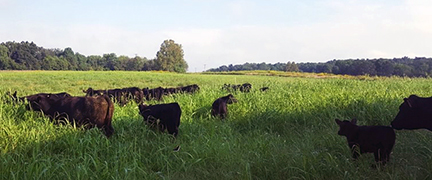Beef and Climate Change: A Continuum
Posted on April 1, 2018, by Susan Classen CoL

Photo by Cody Rakes
Does eating beef harm the planet? Many are asking that important question and, like most good questions, there is no clear answer.
Think of a continuum ranging from beef choices that contribute to the problem of climate change to those that contribute to its solution. The placement of beef on that broad continuum is determined by the health of the cow, the food it ate and the location of its pasture.
Beef from cattle raised through industrial livestock production falls on the far end of the problem side of the continuum. There is significant consensus that the large amount of methane produced from factory-farmed cattle contributes to climate change. Many of the beef-related studies look primarily at this perspective. If you are standing at the meat counter in the grocery store wondering if you should buy the beef, the answer is probably “no” since it likely came from industrial cattle operations.
But what if you’re standing at the meat counter and see a small section of “grass-fed” beef? Cattle which graze on pasture can contribute to the climate change solution because pastures sequester carbon and lock it in the soil. That confirms that “grass-fed beef” is better for the planet. Right? Well, it depends …
All cows eat grass, so the label “grass fed” could actually be applied to all beef. Some producers add “grass finished” to the label, distinguishing their beef from cows which are fed grains to fatten them just before butchering. So, should we all buy “grass-finished” beef? Well … the most important question isn’t answered on the label.
The key question is, “How healthy was the cow?” Healthy cows produce less methane regardless of whether they ate just “grass” or both “grass” and grains. I put “grass” in quotation marks because it raises another issue with labels. Pastures are made up of more than grass, and a package of meat gives no clue as to the quality of the pasture. A good pasture is a cornucopia of diverse greens, including grasses, legumes and other perennials. Farmer and author Joel Salatin calls his lush pastures “salad bars.” Maybe we could advocate for a new label — “salad-bar” beef!
There’s still another issue though, which shifts where that package of beef might fall on the continuum. Where was this healthy pasture located? The United States imports large quantities of beef from Brazil where some producers are cutting down tropical rainforests to make room for pastures. Both shipping distance and deforestation mean that eating beef from Brazil, regardless of the health of the cow, contributes to the problem, not the solution. We all need to pay attention to location before we buy that package of beef.
An ecological perspective recognizes that all natural ecosystems include animals. Wild ruminants like buffalo once freely roamed the prairies, contributing to the health of both the landscape and its inhabitants. It seems well within our human capacity to manage domesticated ruminants like cattle in a way that contributes to the health of the ecosystem and to human health. Many farms in Kentucky, including the Motherhouse farm, raise cows on pastures located on rocky hillsides unsuitable for cultivating plant-based food like vegetables, fruits and grains. Beef falls closer to the solution end of the continuum when it’s raised on land not suitable for other food production.
Let’s get back to our original question. Does eating beef harm the planet? My personal conclusion is that we can choose to eat beef that contributes to the health of the planet by eating less but higher quality beef. The generic-brand beef at the grocery store likely falls on the problem end of the spectrum, so find a local beef producer whom you trust is raising healthy cows on healthy pastures.
If you don’t have the option of a local beef producer, you can research a reputable brand keeping in mind three components that, together, move beef toward the solution side of the continuum. Those components are healthy cows, good pasture and appropriate location. Your meat will cost more in dollars and cents but will cost less in harm to the planet.
